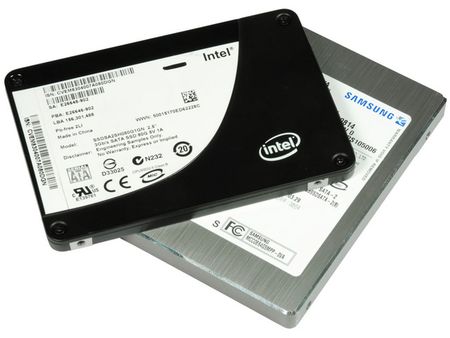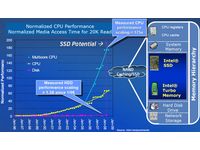Intel's X25-M Solid State Drive Reviewed
Intel’s First Flash SSD Ready for Vertical Take-Off
Looking back at recent developments in the flash solid state drive (SSD) market, we could tell that it was only a matter of time until Intel jumped in feet-first. Flash-based hard drives are about to assail the hard drive market from the very high end, where conventional hard drives are being outperformed by flash products, and from the low end, where cost and low power consumption count most. However, the mainstream has remained largely ignored, due to insufficient capacity, the intolerable cost of flash SSDs, and shortcomings, such as the absence of the power savings promised by many flash SSD makers. Being a true flash memory vendor—as opposed to so many others out there—Intel has the advantage of being able to design and refine its own product. And that’s what it has done. The X25-M is a multi-level cell (MLC) flash based drive that is capable of competing with the best single-level cell (SLC) drives on the market.
Flash SSD Facts and Overview
A solid-state drive means that the unit doesn’t include any moving parts as conventional hard drives do. As a result, flash SSDs are robust and potentially much more efficient. They’re also capable of providing almost instant access to data, while hard drives have to spend time moving arms and spinning disks to access individual blocks. We looked at the first flash-based SSD by Samsung exactly two years ago. It reached the 50 MB/s transfer speed that was offered by comparable 2.5” drives at that time, but it required half the power to operate.
The first retail products appeared a year later from Sandisk, Samsung and Ridata, and others followed a few months later, offering nice performance and attractive efficiency. But they still did not truly beat the magnetic hard drive.
M-Tron was the first company to ship a flash SSD that is actually capable of outperforming a hard drive very clearly. MemoRight followed up with increased performance, clearly positioning high-end flash SSDs to replace enterprise hard drives, but we found that most of the flash-based SSDs, despite being faster than hard drives, still could not provide improved energy efficiency (with a few exceptions). For us this is a huge issue, as everyone speaks about power savings, which, in fact often weren’t there. Our last article, which compared 14 flash SSD products, only recommends the latest offering by Samsung (also sold by OCZ), which combines impressive performance with excellent efficiency. The cost issue, however, has remained: good flash SSDs are expensive, to the point of being unaffordable to mainstream buyers.
The Intel Promise: 175x Better Disk Performance
Back at the Intel Developer Forum (IDF) in San Francisco last August, Intel provided an insight into its flash SSD family, and spelled out the main performance points. One of the claims was a 175x performance boost over hard drives, which have only shown incremental performance increases over the last 10 years. This reflects our findings in the article Capacities Outran Performance, which we released almost two years ago. Some of you may already know the key data from various news and announcements: Intel intends to reach 250 MB/s read speed at 0.085 ms access time and revolutionary lower power consumption. This clearly is a challenge to the big guys in the flash market, namely Samsung, Toshiba and Hynix. Intel, which takes the fifth position behind its joint-venture partner Micron, obviously wants to change the balance of power by entering the storage business. Others, such as Hitachi, Seagate and Western Digital, are certainly watching closely. Let’s look at Intel’s first shake up of this competitive market.
Get Tom's Hardware's best news and in-depth reviews, straight to your inbox.
Current page: Intel’s First Flash SSD Ready for Vertical Take-Off
Next Page Intel’s SSD Plans

